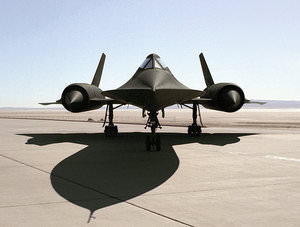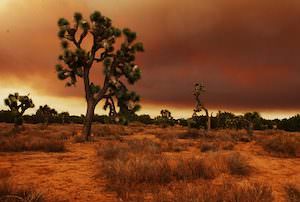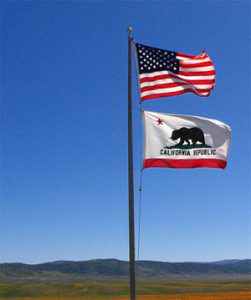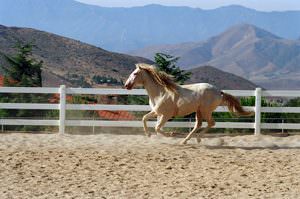Look Homeward, Angels: California and the Rise and Fall of America’s Space Program
While much of the coverage of the end of the space shuttle age has focused on Florida, the launching pad for many missions, it should be recalled that another region of the country was equally important: the Antelope Valley of Los Angeles County and, in particular, the Mojave city of Lancaster.The little-known Mojave city of Lancaster may have been one of the most powerful places in the world.
Letter From the West is a monthly series by Deanne Stillman that explores what is going on in our wide open spaces and what we do to one another and all that lives there.
To commemorate the end of the space program, I decided to watch the movie “October Sky,” which is all about its beginning. It starts in 1957, when a monumental thing occurs: Man grows wings and leaves planet Earth, circling it for the next three months in a satellite called Sputnik. Although it did not have a pilot, citizens of all nations were aboard the Russian ship by way of radio transmissions that were broadcast everywhere. In classrooms across America, children sat and listened to the eerie static and high-pitched wheeees and other assorted odd sounds that seemed to be coming through from another dimension. One of the children who heard the broadcast was Homer Hickham, responding to the sounds with a love of rockets that helped propel him out of a deadly Appalachian mining town and into the new frontier, as JFK later called the uncharted territory of the Big Dipper and Orion’s Belt and the Milky Way.
In the movie, Homer confronts his reluctant and fearful father, who runs the local mine and hopes that his son will some day reach that pinnacle. But Homer’s gaze is fixed on the heavens. When an accident incapacitates his father, Homer is forced to give up his dream and follow the family trail into the mines and darkness. But thanks to an intervention from his mother, Homer’s dream prevails. At the end of this tale, father joins son as they launch a rocket together, a moment of joy that reunites them, sending Homer on his new path as a rocketeer at NASA. At the iconic outfit of extraterrestrial exploration, he becomes a pivotal figure in America’s space program. The story told in “October Sky” is true. And the escape route it portrayed so well may now be permanently closed.
While much of the coverage of the end of the space shuttle age has focused on Florida, the launching pad for many missions, it should be recalled that another region of the country was equally important, if not more so in some ways, in our explorations of outer space. I refer to the Antelope Valley of Los Angeles County, and in particular the Mojave city of Lancaster. Hardly as well known as many other parts of California, its population is still relatively small (300,000), although until recently it was one of the fastest-growing areas in the state. And in many ways it may be one of the most powerful cities in the world, considering that it and its environs are a vortex of might, munitions, engineering feats, flight records, outer space exploration, rocket science and nearly every other method by which America has attained complete air supremacy around the planet. Downtown Lancaster features its own answer to the Hollywood Walk of Fame: A strip there honors Chuck Yeager and other aviation pioneers — a parade of people known for having the right stuff. (Say what you will about American domination of the ethers, but who would dare call what these men had “the wrong stuff”? It would be blasphemy at its most extreme.) These American heroes are depicted in elaborate frescoes on the walls of local establishments, painstakingly created portraits that preserve these men for as long as the elements will permit it. There’s even a main drag called Challenger Way, and a stealth bomber is parked forever at a main intersection — not a sculpture of a stealth bomber, but the real thing; a frank and stunning monument to power.
At nearby Edwards Air Force Base (at 301,000 acres the second-largest U.S. air base in the world), vast arsenals lurk in the sands, issuing a statement that crosses all language boundaries and only other men of the desert have dared to answer. At the Lockheed Martin “Skunk Works” and the hush-hush Air Force “Plant 42” in neighboring Palmdale, new technology is being dreamed up, cooked, molded, hardened and polished as I write, and every day, every few minutes in fact, warrior pilots in the Antelope Valley take off in sleek airborne envelopes, plying the skies and patrolling the world, seated at the controls of sophisticated, top-secret machinery that was forged in the magic dust of this region. Out of these glittering swirls came the U-2 spy plane, the F-22 Raptor (as with many high-speed aviation vehicles, its design is derived from the flight patterns and mechanics of real birds of prey), and the legendary SR-71 Blackbird, the titanium jet that moves at Mach 3.2 at 80,000 feet, has a range of 4,000 miles and is said to have kept Russia at bay during the Cold War; its feats are so astonishing that to this day no one except the people who made it and fly it know exactly what it does, and they are sworn to secrecy. Retired in 1999 (although rumored to still be in service, somewhere up there), it is now on display at the Blackbird Air Park at 25th Street East and Avenue P in Palmdale, along with the A-12, its predecessor, and the airborne workhorse of the 1950s, the U-2. Together, these jets represent four decades of a shadow history in which design visionaries such as Kelly Johnson at Skunk Works and dream factories such as Lockheed, Boeing and Northrop made it possible for America to win the battle for the heavens.
In a way, the whole thing started with dry lake beds, those great prehistoric wastes which seem to issue a challenge: “Hey you!” they call. “Come have a party! Fly me!” From the beginning of the 20th century through the present, many private citizens and a parade of military institutions have come to see the Antelope Valley as a place where you can test limits — and in fact the Antelope Valley is also called Aerospace Valley. In 1902, an early Antelope Valley settler set the first of many land speed records on Rosamond Dry Lake, whizzing across the sands on a sailboat with wheels. In 1902, the Corum family decided to homestead on the west side of Rogers Dry Lake, and soon a few others followed; thus was born the small town called Muroc — “Corum” backwards. From 1926 to ’33, many car-racing records were set on the Rosamond and Muroc dry lakes, including those set by racing legend Tommy Milton. Blind in his right eye, Milton piloted a rocket-like capsule on four wheels powered by his signature Miller hyper-engine across the Muroc flats at 141 and then 151 miles per hour, winning the tough international Class C and D championships in 1924 and bringing more attention to the wonders of the Mojave. By 1933, the military had moved into the desert, and the Air Force set up its first permanent base at Muroc. In 1942, America’s first jet, the Bell XP-59A Airacomet, made its first flight there while World War II raged on two fronts. The news was kept under wraps for years. In October 1947, Capt. Chuck Yeager broke the sound barrier when he flew the Bell X-1 rocket research airplane at a speed of Mach 1.06, after it was dropped from a B-29 mother ship. Again, the news was withheld, until December of that year, when Aviation Week announced the stunning accomplishment. Over the years there would come many more aerospace feats and breakthroughs above the desert sands where they had been dreamed up.
But it would take a woman named Pancho Barnes to take the party to the next level. Born in 1901 to prominent Pasadena parents, Barnes got married at 18, hated her high-society life, dropped out and embarked on a lifelong career of adventures, becoming “Pancho” instead of her given “Florence” after wandering the wilds of Mexico in 1928. Back in the States, she took to the skies and soon was one of the first women in the country to earn a pilot’s license. She raced in air derbies with Amelia Earhart and in 1930 topped Earhart’s speed record, clocking in at 196.19 miles per hour. Barnes also was a test pilot for military aircraft. Soon Hollywood came calling, offering her work as a stunt pilot. She quickly developed friendships with Gary Cooper, Tyrone Power and Errol Flynn. One day, while flying over the Antelope Valley in her capacity as test pilot for Lockheed, she spotted an alfalfa farm between Rosamond and Rogers dry lakes. In 1935, she bought it and moved there; it soon became the Happy Bottom Riding Club, at one time as legendary for its desert soirees as Burning Man.
The first thing Barnes did was carve out a landing strip so her friends could fly in for parties. Within months the property turned into a full-fledged spread, with Barnes acquiring cattle, pigs and horses, setting up a saloon, a restaurant, a dance hall and motel. And thus her relationship with the military flourished. She supplied meat and milk to the Muroc Bombing and Gunnery Range and entertainment in the form of glamorous hostesses who worked at her bar. Chuck Yeager and other noted pilots of the era were regulars at the Happy Bottom Riding Club. Later, Barnes would look back and say, “We had more fun in a week than most of the weenies in the world have in a lifetime.”
But parties must inevitably be shut down; Muroc had become Edwards Air Force Base and the burgeoning flight program needed more land — or so went the claim. The military made a move to condemn the Barnes property and acquire it. Barnes fought the acquisition in court in a trial that gained international notoriety, with the Air Force accusing her of running a brothel and Barnes fighting for property rights — the kind of desert battle that continues to this day. “They picked the wrong gal to push around,” Barnes said, and as the trial exploded, the Happy Bottom Riding Club went up in flames. As the ranch smoldered, Barnes won her case — but the party was over and the legendary pilot and friend of the military retreated to another small town in the desert. She fell out of touch with her Air Force pals and they did not seek her company. Finally, in 1961, she was acknowledged as “The Mother of Edwards Air Force Base.” On April 5, 1975, she was scheduled to speak at the Antelope Valley Aero Museum’s annual Barnstormer’s Reunion. But a few days before the event, she died. Her funeral was attended by such luminaries as Chuck Yeager, Buzz Aldrin and Gen. Jimmy Doolittle, who eulogized this great figure thusly:
… [She] had “a heart as big as a ham.” … She put great store by courage, honor and integrity. She despised dishonesty and cowardice. She was straightforward and abhorred sham. You know, I can just see her up there at this very minute. In her inimitable way, with a wry smile, she is probably remarking to some old and dear friend who preceded her, “I wondered what the little old bald-headed bastard was going to say.” … And may I now propose a toast: Ladies and gentlemen — to Pancho Barnes. Pancho Barnes!
By the time Barnes had died, the Antelope Valley was in a boom period, filling up with those who had come to work in the expanding aerospace industry. No one typifies this boom more than longtime Lancaster resident Bob Gonzalez. Born in Santa Ana in 1936, Gonzalez’s parents were self-educated, naturalized citizens from Mexico who had come to California around 1916 to seek the golden dream — their own version of the story told in “October Sky.” During World War II, Gonzalez’s father was employed as a welder in the Long Beach shipyards. When the war ended, Gonzalez, in high school, would travel with his father to the San Joaquin Valley during the summertime to work the orange groves along with some of his siblings. “I used to put cardboard inside my shoes for soles,” he told me as he recalled the old days. “We slept on a bed under a fig tree. There were so many mosquitoes, we lit fires to keep them away. It got so bad I couldn’t take it.” In 1954, Gonzalez quit high school and joined the Air Force. He was sent to tech school to learn all about aerospace. Soon he was stationed in England, where he met the woman he would marry. They returned to the States and were transferred from base to base as Gonzalez rose through the ranks. In 1969 he was sent to Vietnam, where he worked as an aircraft engine superintendent at a base in Saigon. As the war raged, his wife, Sheila, was living at a trailer park in Rosamond, raising their four children. After his one-year tour, Gonzalez was sent back to the States. He retired on July 1, 1974, after 20 years of service with a deep knowledge of how airplanes worked, how to keep them running and how to manage the teams of people who made them fly. One week later, he got a job at the General Electric plant on Edwards Air Force Base. He was hired to work on the B-1 bomber.
Then Gonzalez bought a house in Lancaster, where some of the area’s early tracts had just been built. There were two tracts called Larwin. “We found a wonderful house in the second one,” Sheila recalled in a conversation on her porch. “It cost $30,000 and we got financing through a VA loan.” Its most alluring feature was that it was “all-electric” — which meant that bills for the water heater and furnace would be kept to a minimum, just as the famous and now very quaint “live better electrically” General Electric ads of the era promised. “There were only six houses in our tract then,” Gonzalez recalled. “The tumbleweeds would pile up at the door. Everybody was proud of their lawns.”
As it happened, Gonzalez never worked on the B-1 bomber. Instead he worked on other classified programs, going back to school to study airplane design and engineering and ultimately working on some of the country’s premier aircraft. He was at Edwards for 19 years, until 1993 when he and many other employees were laid off during an “RIF” — a reduction in force, also known as “We’ll farm it out,” Gonzalez said. By then, there were 200 homes in his tract and the main drag that ran parallel to his lot was called Challenger Way, renamed in tribute to the space program that had flourished at Edwards. Yet it was a time of economic downturn and an Antelope Valley that depended heavily on the aerospace industry was hit hard. Solid working-class neighborhoods like Larwin began to change; some houses were foreclosed on, empty dwellings filled up with squatters, and absentee landlords began renting out to welfare refugees who received Section 8 housing aid.
But Bob Gonzalez wasn’t going anywhere; he had sunk roots in Lancaster and there he and his family would stay, through all the boom and bust cycles, because for him he is a short distance but a very long way from the fruit fields of the San Joaquin Valley. Today, he is a great-grandfather who spends his days fishing, traveling and tinkering in his garage as sonic booms thunder across the big skies of the Antelope Valley. He likes the sound of the passing jets, and he always marvels at the contrails in the skies. Although his humble demeanor would never betray such a thing, he’s proud of having worked on the very thing that made America what it is today, a quiet accomplishment that helped his family flourish in a time when hard work was valued. In the Antelope Valley there are thousands of people just like Bob Gonzalez, and they are all one of a kind.
On any given day in the Mojave, when wind conditions are right, and often enough even when they are not, you can see boys setting off rockets at a dry lake bed. Sometimes they are with their fathers and sometimes with their friends. Sometimes they are by themselves, lonely not at all, putting the final touches on a flying vessel that they made. Carefully they insert the fuel, tenderly they fold the parachute so the rocket can return. They arrange it just so on the launching pad and then proffer a flame, stepping clear of the blastoff and watching the vessel rise, lost and found in that delirious moment when it leaves the Earth, slices through the air, pauses as the second stage engages, regaining speed and picking up some more, racing toward the heavens.
“Look at it go, Homer,” a friend says to the boy as they launch a homemade rocket in “October Sky.” “This one’s gonna go for miles.”
Your support matters…Independent journalism is under threat and overshadowed by heavily funded mainstream media.
You can help level the playing field. Become a member.
Your tax-deductible contribution keeps us digging beneath the headlines to give you thought-provoking, investigative reporting and analysis that unearths what's really happening- without compromise.
Give today to support our courageous, independent journalists.




You need to be a supporter to comment.
There are currently no responses to this article.
Be the first to respond.